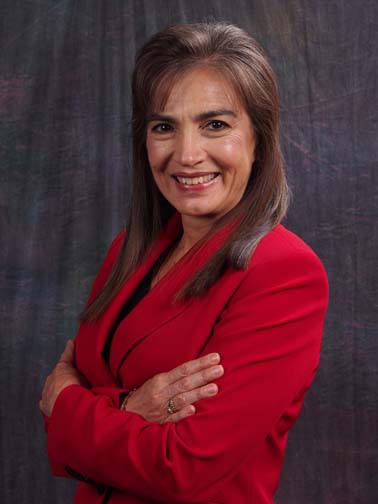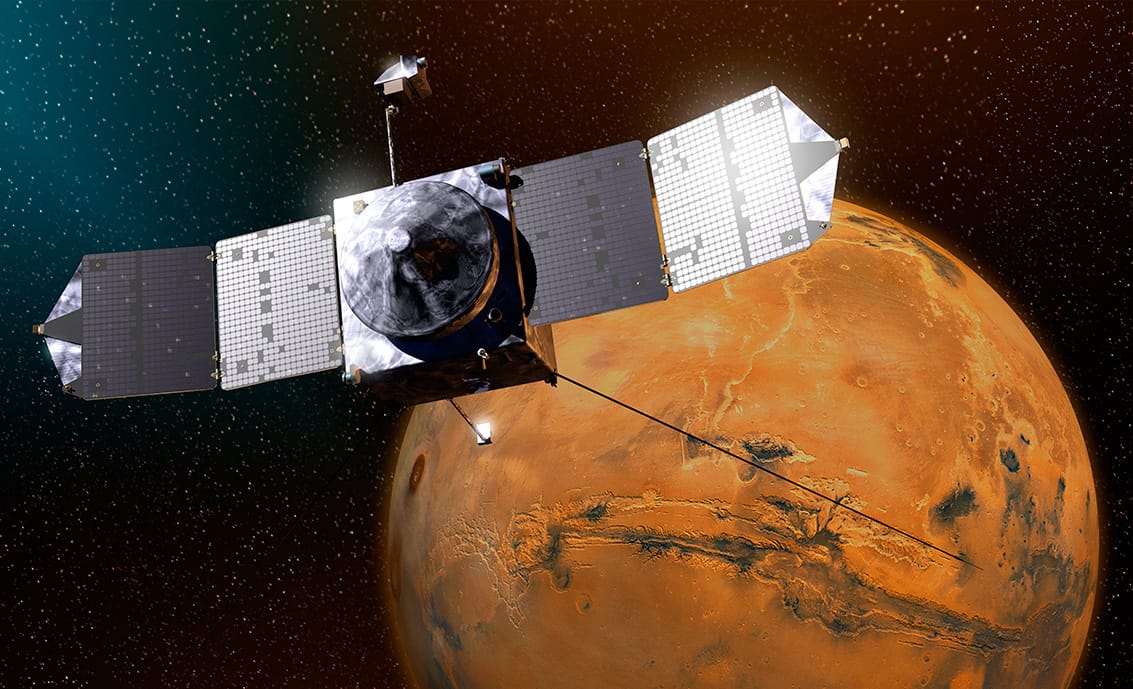
TT: Can you tell me a little bit about what MAVEN is and what the goal of the project is?
SC: Maven is a satellite that we are going to put in orbit around Mars. We launched last Nov. 18, and it is going to arrive at Mars this coming Sunday at 9:50 p.m. EST. The purpose of the mission is to study Mars’ upper atmosphere, and it is the first mission solely dedicated to studying the martian upper atmosphere.
Why is NASA interested in studying the upper atmosphere of Mars?
Well, first of all, we have never done it. There is evidence that Mars had water on the surface, but the atmosphere right now is not thick enough and does not provide enough pressure to sustain water on the surface. So we want to study the processes that have occurred on Mars over billions of years that have contributed to that loss of atmosphere to space.
We know that Mars does not have a magnetic field like Earth does. That magnetic field protects Earth from solar winds that strip the atmosphere. Since that protection doesn’t exist on Mars, over the years it has become a desert-like planet. It is very dry, very airy and the atmosphere is very thin. So the satellite is going to try to analyze the processes causing this to happen, it is going to measure the rate of escape of the gas to space and we are going to try to extrapolate how Mars was 14 billion years ago and uncover if it had water. The implication is that if it had water it probably had some form of life.
We also want to see if the same thing that happened on Mars is occurring here on Earth with climate change, and if there is anything we can do about it to prevent Earth from becoming like Mars.
This project is an early scout mission to send humans to Mars, correct? What is NASA hoping to learn about Mars that would one day help send people there?
This is a piece of the puzzle for the human Mars missions that we have planned in the future. Several satellites we have sent have already measured radiation, and this one is to study the atmosphere. We have another that will launch in 2016, a lander, and it is going to analyze the heat flow on Mars.
We want to understand what Mars is like is so we know how to prepare astronauts in the future for a trip there. To do that we need to analyze the planet and know everything we can about it.
What is your role in the MAVEN mission?
I am the deputy project manager, responsible with all aspects of the mission. I work very closely with the project manager and the two of us have oversight over all of the technical schedules of the mission. We work directly with the principal investigator for the mission, Dr. Bruce Jakosky, who in 2003 was the one who had this idea to study the Mars upper atmosphere. Of course, we also have a whole team to help manage this mission. We have over 400 people working on different aspects of MAVEN.
What is your day-to-day at NASA like now and how will that change once MAVEN gets to Mars?
I am part of the development team and am responsible for taking the idea for a mission and helping it become a reality.
We have a lot of requisites we need to meet. We have to make sure all of the instruments are meeting the requirements. Project management really is all about risk management. We have to make sure we look as far ahead as we can in order to prevent any problems that we may perceive now before they become an issue.
Once we launch the mission and do the full checkout, my job is done and I move on to another project from the beginning. I am not part of the operations team. In fact, I already started working with another scientist, developing another mission. So once we are in orbit, I have about five more weeks on this project while we do the final instrument check and then I move on.
How does it feel to be approaching the end of this very large project?
It is exciting any time you get to this stage.
The launch is scary and one of the most critical moments. When you see the rocket take off, then the separation, then the solar panels raise up, you breathe easier. You know that is just a really critical moment. But, once you know that the satellites are fully operational and gathering the scientists data, that’s the moment we prepare for. What we want is to obtain data for scientists who want to discover something new, and now we are all very excited that we are almost there.
We are all holding our breaths because three days out the satellite is completely autonomous. We uploaded the script already and we hope that the satellite will start executing the commands around 9:50 p.m. EST on Sunday night. For 33 minutes it needs to be trying to slow itself down in order to grab onto the orbit of Mars. Once we know it is securely around Mars we are all going to breathe a little bit better.
We know we did everything we could but once it is out in orbit, we cannot change anything.
When you’re not directing space missions, what do you like to do?
I am married and have two sons who are 22 and 19.
As a hobby, I do hot yoga. It’s a 90-minute routine in 105 degrees. I also enter competition on the rowing machine. I also love to cook. I am always making up new recipes and I haven’t killed anyone yet.
Do you ever cook any Costa Rican dishes?
Of course! I am always making rice and beans and I love yucca. I make picadillo all the time.
When did you first become interested in space and in the idea of working at NASA?
When I was 7 years old watching the Apollo 11 moon landing. At that time, it was a momentous event and everyone wanted to watch the first human on the moon. I was just another one of those people, but at that moment I decided that I wanted to go to the moon.
I didn’t go to the moon and I don’t think I could ever be an astronaut. I am too old now anyway. But I knew what I wanted to do. The world has gone around and around many times since then, and I didn’t go to the moon but I am working about as close as I can get.
Can you talk about the challenges you faced here in Costa Rica before moving to the U.S., and how you got to where you are today?
I had a very hard childhood until I was about 17 years old. My mother was a single parent. I grew up in Hatillo and went to the the Escuela República del Paraguay and the Colegio Luis Dobles Segreda. It was very hard at the very beginning because when I was little my father treated us very badly. So eventually, my mom separated from him.
We started roaming from place to place and my mom had 2-3 jobs at a time. Then, when I was 17, my mom married my adopted father, who was from the U.S. I went to the University of Costa Rica for three years and then my father moved our family to the U.S. where I finished school in Virginia [at George Mason University]. They only accepted 31 of my 120 credits, but I graduated with two degrees, one in electrical engineering and one in physics. I always joke that I took the 7-year plan, but I did get those degrees and it was worth every minute.
After I graduated, I went to a job fair and I got hired on the spot for a contractor for NASA. I worked there for three years and once I became a U.S. citizen I was able to apply at NASA. I got the job and I have been here for 23 years now.
What advice would you give to other young Ticos who want to work at NASA or another large science and technology firm one day?
One of the things I always tell kids is don’t stop dreaming. Dream and dream and try to reach those goals because the more impossible the dream is, the further you will go trying to reach it. You may never reach your lofty dream or your lofty goal, but don’t settle for less. Don’t just assume because you came from a poor family that you can’t achieve what you want to achieve.
You don’t know what opportunities may arise. You need to be ready to grab them and go with them. There is some luck involved sometimes. I was lucky my mom met my dad and that he brought us here, but there are a lot of opportunities in Costa Rica. There is still a lot of work that needs to be done, but the country is full of smart and talented people.
What would you like to see Costa Rica do to grow science and technology sectors here?
I think there are a lot of things that Costa Rica can do to attract the technology sector in terms of incentives. There are a lot of companies that would love to go to a stable country with smart people, and the government needs to decide what kind of incentives they want to give. A lot of space technology could be developed in Costa Rica, but there has to be a will and a desire. Somehow the ball has to start rolling.
My intention after I retire is to go and help with this in Costa Rica, but I don’t know in what way yet. I would like to do something like what Franklin Chang has done by starting a company or a foundation to help kids. [Costa Rican astronaut Franklin Chang founded Ad Astra Rocket Company in Liberia]. Something to help further sciences and science education in Costa Rica.








